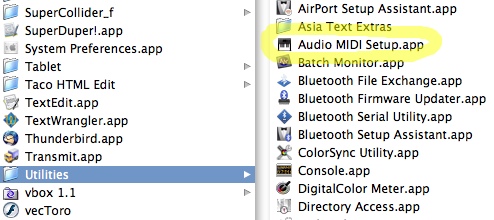CSS and Internet Explorer
Tuesday July 24th 2007, 4:23 am
Filed under:
InternetAll versions of Internet Explorer have problems correctly interpreting CSS. There are ways to improve IE compatibility, however, and one of the simplest is the following markup, called a doctype declaration:
<!DOCTYPE html PUBLIC "-//W3C//DTD XHTML 1.0 Transitional//EN"
"http://www.w3.org/TR/xhtml1/DTD/xhtml1-transitional.dtd">
Paste it at the top of your document, before anything else. See here for a detailed explanation of how it works.
MIDI Over a Network (OS X)
Thursday July 05th 2007, 3:01 am
Filed under:
MidiOS X Tiger includes a useful new feature: you can now send MIDI between computers over an ordinary network. You don’t need any additional hardware, and the connection appears as just one more ordinary MIDI port available to your applications. It’s a simple and effective way to have multiple laptop performers share control information, or to coordinate multiple computers during a live show.
Before starting this tutorial, you’ll need at least two OS X Tiger Macs that share a network. If you have WiFi, you can follow this tutorial first to create a direct wireless connection, without going through a router. (However you set it up, remember to turn off your firewalls first, or else make sure that they’re not going to interfere.)
Step 1. Find and launch the Audio MIDI Setup utility:

Step 2. Go to the MIDI Devices and open the Network device:

Step 3. To start with, use the following settings:

Step 4. Choose a computer from the list and connect to it:

Step 5. If you’re successful, the computer will now appear in the Participants list. If you can’t connect, your network settings are most likely to blame. (Check to see whether you can do other ordinary network tasks, like copying files from the other computer.)

Note: On some older Macs, closing the Audio MIDI Setup utility appears to break the connection. Try it and see–if you have this problem, you’ll have to keep the utility running to stay connected.
Step 6. If everything has gone smoothly, you’ll have created a new MIDI Port with the name Network (Session 1). Select it from inside a MIDI program and test it out!








